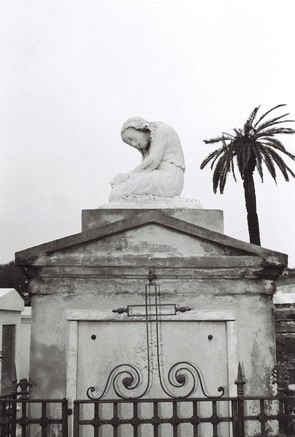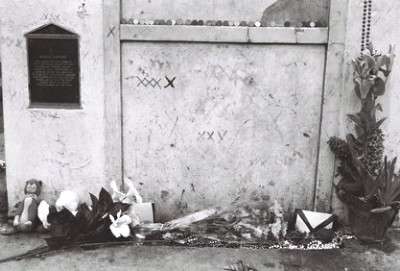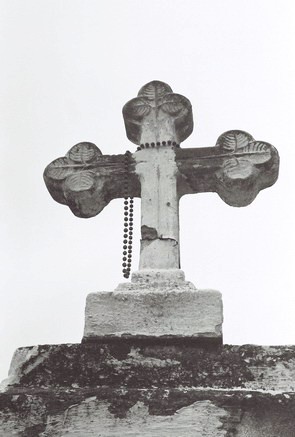On my last evening in New Orleans I decided to go visit the oldest boneyard in New Orleans, St. Louis Cemetery #1, founded in 1789. Yes, on my last EVENING. I'm not sure why it didn't occur to me that the cemetery would be CLOSED at night. Maybe I thought I'd be able to peek through a fence or something (it's actually surrounded by a tall, white wall). In any case, the cemetery was outside the safety-circle the desk clerk had drawn for me, but I wouldn't realize this until I got back to my hotel room.
 So, I set off, crossed Canal St., and kept going. I soon passed a man who bid me a very hearty "Good evening!" I responded in kind, and thought, "Very friendly folks around here!" About a block later I caught the vibe. Abandoned grocery store on one side, boarded-up building on the other. Very few people on the streets. My antennae went up. Way up. But I was pretty close, so, sun going down, I pressed on. Another guy walked past, and he, too, offered a friendly "Hello!" Only, this time, I thought I detected a trace of amusement in his tone. When I made it to the cemetery it was, of course, locked up tight as a drum. I circled it, just to feel like I'd accomplished something, and found a hole someone had bashed in the wall. It was large enough to crawl through and, incredibly, I actually considered squeezing in. Luckily, I realized that other people may have recently done the same thing and I didn't want to meet them under the circumstances. So, I turned around, kept my head down, and quickly walked back to my hotel in the dark. Failure.
So, I set off, crossed Canal St., and kept going. I soon passed a man who bid me a very hearty "Good evening!" I responded in kind, and thought, "Very friendly folks around here!" About a block later I caught the vibe. Abandoned grocery store on one side, boarded-up building on the other. Very few people on the streets. My antennae went up. Way up. But I was pretty close, so, sun going down, I pressed on. Another guy walked past, and he, too, offered a friendly "Hello!" Only, this time, I thought I detected a trace of amusement in his tone. When I made it to the cemetery it was, of course, locked up tight as a drum. I circled it, just to feel like I'd accomplished something, and found a hole someone had bashed in the wall. It was large enough to crawl through and, incredibly, I actually considered squeezing in. Luckily, I realized that other people may have recently done the same thing and I didn't want to meet them under the circumstances. So, I turned around, kept my head down, and quickly walked back to my hotel in the dark. Failure. 
 Homer Plessy (1863-1925), a black man who sat in a "whites-only" railroad car, leading to his role as plaintiff in Plessy v. Ferguson, is buried there. Remember, Plessy lost his case and the ruling put into law the "separate but equal" doctrine in the US. Also buried in the cemetery is Marie Laveau (1794?-1881?), the Voodoo Priestess. She and her daughter reportedly haunt the cemetery, and return fully to life on St. John's Eve (i.e. Midsummer's Eve), when they lead followers in a wild celebration (i.e. orgy). People requiring a little voodoo in their lives leave coins, stuffed animals, "X"'s--ANYTHING--to get Ms. Laveau to help them. Then, those in need turn around three times, knock thrice on the tomb, and their wishes are granted. Tradition has long held that the Laveau tomb is the one in the middle shot there, but the grave itself has always been unmarked. Did I try to get a little voodoo going on? Wouldn't you like to know. The statue in the top shot is "The Weeping Woman." This last photo features the ubiquitous beads of New Orleans. Thanks to Grave Addiction for providing some info on the Voodoo Queen. They've got lots of interesting photos and facts at the site if you want more. 'Til next time.
Homer Plessy (1863-1925), a black man who sat in a "whites-only" railroad car, leading to his role as plaintiff in Plessy v. Ferguson, is buried there. Remember, Plessy lost his case and the ruling put into law the "separate but equal" doctrine in the US. Also buried in the cemetery is Marie Laveau (1794?-1881?), the Voodoo Priestess. She and her daughter reportedly haunt the cemetery, and return fully to life on St. John's Eve (i.e. Midsummer's Eve), when they lead followers in a wild celebration (i.e. orgy). People requiring a little voodoo in their lives leave coins, stuffed animals, "X"'s--ANYTHING--to get Ms. Laveau to help them. Then, those in need turn around three times, knock thrice on the tomb, and their wishes are granted. Tradition has long held that the Laveau tomb is the one in the middle shot there, but the grave itself has always been unmarked. Did I try to get a little voodoo going on? Wouldn't you like to know. The statue in the top shot is "The Weeping Woman." This last photo features the ubiquitous beads of New Orleans. Thanks to Grave Addiction for providing some info on the Voodoo Queen. They've got lots of interesting photos and facts at the site if you want more. 'Til next time.
4 comments:
Hello! I'm glad you liked the site and found some helpful information on it :) The photos you took in New Orleans are terrific!!
Hey JM,
And it was assumed that Plessy was an easy case at that point. He sat where he "shouldn't have" in order to get arrested, go to trial, and... win. But that didn't happen, did it? Well, to hell with Jim Crow, we've got one more creep looking at 60 years (which'll make him 140 when he gets out!)
-zb
Nice shots, and the narrative really adds to them. I really like the choice of B&W for the subject matter.
The density of the cemetery really surprised me, as the only time I've ever seen cemeteries so compact before was during my trip to the Philippines (at least, the poorer parts - the cemeteries for the rich consisted of stand-alone buildings larger than my apartment for those who wanted to be buried in excess - occasionally they were considerate enough to leave a plot or two inside the chamber for their family members to join). Very interesting stuff.
Post a Comment